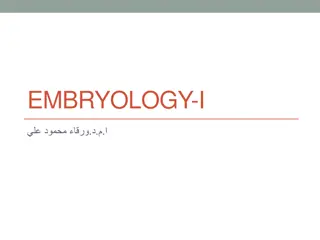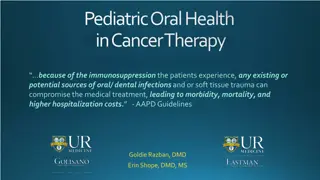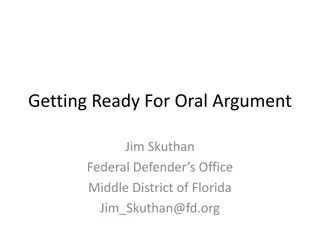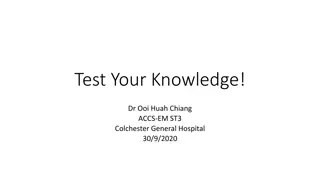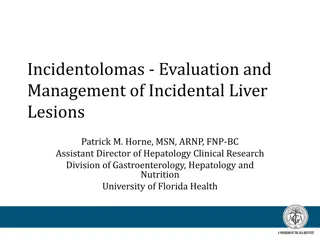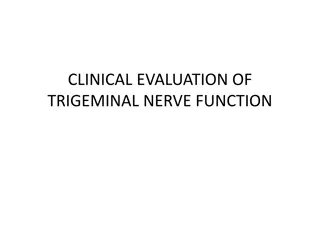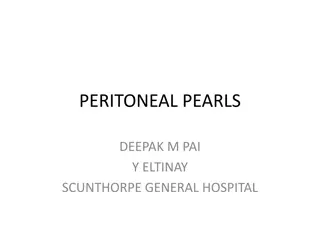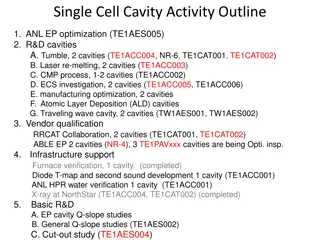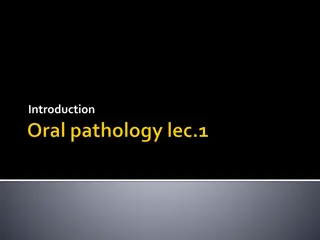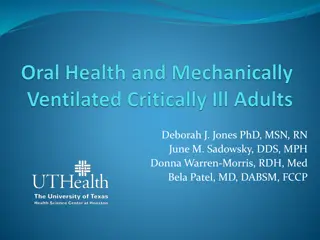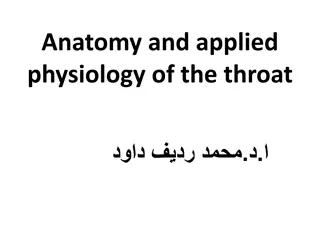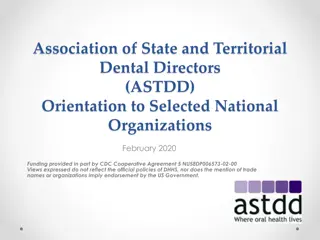Reactive Hyperplastic Lesions in Oral Cavity
Reactive hyperplastic lesions in the oral cavity result from controlled cell proliferation in response to low-grade irritation or injury like trauma, and include conditions like pyogenic granuloma which are non-neoplastic tissue responses to local factors. These lesions are commonly seen in the gingiva and can occur in other oral locations, exhibiting varying histological appearances and behavior. Proper identification and management are crucial for these oral conditions.
Download Presentation

Please find below an Image/Link to download the presentation.
The content on the website is provided AS IS for your information and personal use only. It may not be sold, licensed, or shared on other websites without obtaining consent from the author.If you encounter any issues during the download, it is possible that the publisher has removed the file from their server.
You are allowed to download the files provided on this website for personal or commercial use, subject to the condition that they are used lawfully. All files are the property of their respective owners.
The content on the website is provided AS IS for your information and personal use only. It may not be sold, licensed, or shared on other websites without obtaining consent from the author.
E N D
Presentation Transcript
REACTIVE HYPERPLASTIC LESIONS OF THE ORAL CAVITY L 13
Hyperplasia means controlled proliferation of cells without any cytological abnormality. Reactive lesions are non neoplastic swellings which show a response to a low-grade irritation or injury, such as chewing, food impaction, calculus, iatrogenic injuries such as broken teeth, overhanging dental restorations and extended flanges of denture
. Chronic trauma can induce inflammation which produces granulation tissue with proliferation of endothelial cells and fibroblast and chronic inflammatory infiltrate resulting in overgrowth called reactive hyperplasia. Reactive lesions are commonly seen in the gingiva (Epulis) and their occurrence in other places of the oral cavity, such as the tongue, palate, cheek and floor of the mouth is less common. They include:
PYOGENIC GRANULOMA The pyogenic granuloma is an exuberant tissue response to local irritation or trauma It is not a neoplasm. The young lesions are highly vascular, soft, red or reddish purple, pedunculated or sessile lesions which bleed easily. Older lesions tend to be more collagenized and pink in appearance. Seen more frequently in the maxilla.
The pyogenic granuloma and pregnancy tumor (epulis) have an identical histologic appearance and the pregnancy tumor is considered a pyogenic granuloma occurring in pregnant females. The pyogenic granulomas appear on the gingiva in 75% of reported cases with a female predilection. The pregnancy tumor tends to increase in incidence with increasing hormonal levels of estrogen and progesterone up to the seventh month of gestation when the critical stimulatory concentration is reached.
It is recur if excised during pregnancy. It may regress after delivery. Pregnancy epulis. This highly vascular lesion has the same appearance as a pyogenic granuloma clinically and histologically Pyogenic granuloma appear exophytic with a red erythematous surface
The histological appearance is characterized by - Large numbers of endothelium lined vascular spaces. - There is fibroblastic proliferation with a diffuse, often dense chronic inflammatory infiltrate, and usually moderate polymorph nuclear leukocytes infiltration. - The lesion is covered by a thin, often ulcerated layer of stratified squamous epithelium. - Despite the name, no pyogenic material or pus is found in the lesion.
- Treatment involves complete excision of the lesion down to the periosteum or periodontal ligament and removal of local irritants (B) (A) (A) Epithelium overlies a fibrovascular connective tissue. (B) Fibrovascular connective tissue consisting of numerous endothelium-lined vascular spaces engorged with red blood cells (arrows), numerous fibroblasts, and infiltrated with inflammatory cells
. (Left) inflammation produces an appearance indistinguishable from a pyogenic granuloma However, inflammation is secondary change; (right) the mass consists essentially of loose connective tissue supporting many thin walled, dilated blood vessels
PERIPHERAL GIANT CELL GRANULOMA (Giant cell epulis) The peripheral giant cell granuloma is originates from the periosteum or periodontal ligament as a result of local irritation or chronic trauma. It occur exclusively on the gingiva, as a deep red to reddish blue raised lesion which is sessile or pedunculated, seen more frequently in the mandible.
PGCG is a soft tissue lesion that rarely involves the underlying bone. However, superficial erosion of the underlying bone has been reported. Peripheral giant cell granuloma present on the facial aspects of maxillary teeth.
Microscopically - It is covered by keratinized squamous cell epithelium which is often ulcerated. - The most obvious feature is a large number of multinucleated giant cells scattered throughout the lesion. - The lesions contain abundant small capillaries and hemorrhagic foci with hemosiderin deposition. - A diffuse inflammatory infiltrate is often seen containing both acute and chronic cells.
The epithelia overlies the vascular connective tissue which contains numerous multinucleated giant cells. Abundant multinucleated giant cells together with inflammatory cell infiltration and areas of hemorrhage are also seen.
PERIPHERAL OSSIFYING FIBROMA The peripheral ossifying fibroma is a relatively common reactive lesion of the gingiva. The nomenclature for this lesion however has been confusing and is often reported as a peripheral fibroma with calcification. It is thought to originate from the superficial periodontal ligament due to its exclusive occurrence in the interdental papilla, and its proximity to the periodontal ligament. There is a predilection for females.
This raised lesion may appear smooth and pink or ulcerated and erythematous. The clinical appearance may be identical to the peripheral fibroma and both are associated with local irritating factors.
Histologically - Highly cellular fibrous connective tissue with large numbers of fibroblasts are seen associated with a mineralized product that may include bone, cementum-like material, or a combination of each. - The surface of the lesion may be intact or ulcerated stratified squamous epithelium. Cellular stroma with cementoid calcifications.
- Surgical excision is required with aggressive curettage of the underlying periosteum to include scaling of the adjacent teeth and periodontal ligament space to reduce recurrence.
FOCAL FIBROUS HYPERPLASIA - Focal fibrous hyperplasia (fibrous epulis, irritation fibroma, fibro- epithelial polyp)is a broad-based exophytic lesion, and the local irritation is usually present, such as calculus, caries, defective restorations, or trauma. - Lesion usually a small lesion with a slight female predilection - Occurs most frequently on the buccal mucosa. - When the lesion occur on the mucosal surface is called fibro- epithelial polyp and when occur in the gingiva is called fibrous epulis.
-Fibro-epithelial polyps most commonly occur in the buccal mucosa along the line of occlusion - while epulis commonly occur in the maxillary anterior region. - The lesion appears as a raised mass that is pedunculated or sessile with a smooth surface, and is usually the same color as the surrounding gingiva.
Histologically - Poorly vascularity connective tissue seen, the tissue mass consists of bundles of collagen fibers with and few chronic inflammatory cells. - The surface is covered by stratified squamous epithelium and may be ulcerated because of local secondary trauma.
DENTURE-INDUCED FIBROUS HYPERPLASIA (epulis fissuratum) This lesion is caused by an ill-fittingdenture and is generally located in the vestibule along thedenture flange. - It is most common with lower denture. - It is arranged in elongated folds oftissue into which the denture flange fits .
Histologically Itis composed of dense, fibrous connective tissue surfaced bystratified squamous epithelium which shows hyperkeratosis and sometimes ulcerations. Because this lesion does not resolve evenwith prolonged removal of the denture, treatment involvessurgical removal of the excess tissue, relining of the prosthesis, and possibly construction of a new denture.
inflammatory papillary hyperplasia of the palate Itis a form of denture-induced hyperplasia. - It is almostalways associated with a maxillary removable full or partialdenture or an orthodontic appliance. - The palatal mucosa,most commonly the vault area, is covered by multipleerythematous papillary projections that give the area a granular or cobblestone appearance
Histologically - Each of the papillary projections consists of fibrous connective tissue, usually chronically inflamed and surfaced bystratified squamous epithelium. - The erythematous appearanceis generally due to a superficial infection with Candida albicans. Hyperplastic papillary epithelium and inflamed connective tissue.
- The precise cause of this type of hyperplasia is not known. - It is usually related to an ill-fitting upper denture or other removable prosthetic device that is worn continuously, 24 hours a day. - Surgical removal of the hyperplastic papillary tissue may be necessary before construction of a new denture.


